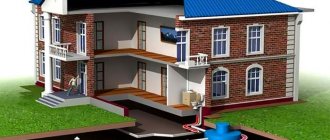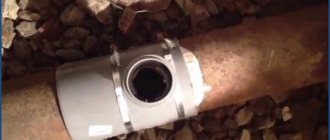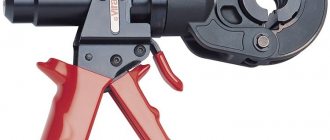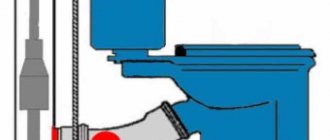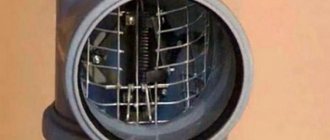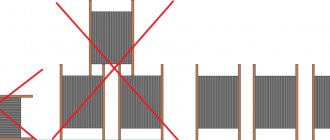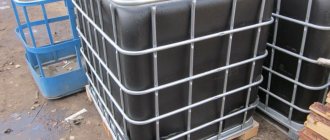A part such as a plug for sewer pipes is used to block certain sections of the drainage network. They are installed by the owners themselves to temporarily or permanently disable a separate branch of the network. In addition, plugs are actively used by utility companies, since the installation of this part is one of the most effective measures to combat debtors.
A plug is installed on a sewer pipe for different purposes. This could be a temporary shutdown of a backup branch or a permanent blocking of a part of the system that has become unnecessary.
Installing an inspection with a plug is necessary to be able to clean the sewer. Such a fitting with a diameter of 110 is placed on the central riser. Recently, management companies have begun to actively use stubs in an attempt to get debtors to pay utility bills.
Purpose of the device
The main difficulty that the management company faces when trying to block defaulters’ access to the use of plumbing facilities is the inability to get into the apartment without the owner’s permission. The debtor often disagrees and prevents such penetration, relying on the right of private property.
In such conditions, the only way out for the management organization is to use the features of engineering structures and networks. Due to this, it is possible to cut off a specific apartment from receiving services without entering private territory. In this case, the interests of the remaining residents of the house will not be affected.
For these purposes, they install a plug on the sewer system and block the debtors' drainage system. Soon it will be impossible to use plumbing.
But the main purpose of the sewer plug is “peaceful”.
It consists in ensuring the possibility of carrying out repair work, inspections, cleaning of individual areas, and covering them, for example, when connecting plumbing and household appliances.
General information
Types of locking systems
There are different types of blocking. The plugs of different systems have distinctive characteristics.
Common devices include the Whale and the Octopus.
The SPRUT plug includes a video camera, a long probe, a blocking plug, and a manipulator.
Positive characteristics of the plug:
- -has a video camera.
- - blocks the sewer riser completely or in parts.
The device is pushed into the sewer pipe through the ventilation, where it blocks the drainage hole completely or partially.
The pipe will not change its geometry, and neighbors in the house will not experience restrictions on the use of the sewerage system.
The plugs are made of steel, which resists aggressive environments and is also not subject to mechanical stress.
The KIT lock has a probe with a control panel and a camera.
Positive characteristics:
-has LED lamps, with the help of which they find the desired apartment.
-has a control panel, you can control the operation of the system from a distance.
The blocking probe passes through the central riser to a specific outlet location where the plug is installed.
Less popular plug systems include:
1.Glot, equipped with a cable with a manipulator at the end and a small video camera.
2.Terminator Pro.
3. The Sov has a plug in the form of a polymer sleeve, which is pressed into the section of the pipeline where there is a debt and closed with a lock.
To remove the blocking, you must pay the debt for the apartment in full.
Stub - a form of dealing with debtors
There are two types of locking systems:
-absolute view covers the waste drain in full.
-the lattice type partially blocks the passage of sewage, allowing passage only for liquid forms of waste.
If the debt is two months old, then housing services have the right to install a plug.
The management organization does not have the right to enter an apartment with debts; it is forced to block the sewer system so as not to cause inconvenience to the neighbors.
Features of installing the plug:
1.specialists study the pipeline diagram and select a location for the plug.
2. determined using one or type of plug.
3.set the lock using a manipulator with a video surveillance camera.
The operator monitors the installation process from start to finish.
Before installation, the defaulter receives a notification that restrictive measures are being applied to him regarding the provision of sewerage services.
If the sewer is closed without warning, the debtor can sue the management company for illegality of action.
Based on judicial practice, it can be argued that this type of case ends in favor of the plaintiff.
Kinds
The plugs that are installed on sewer pipes can be rubber, metal, plastic or metal-plastic. The material of the device must match the material of the section of pipe that needs to be blocked. Therefore, in cast iron pipes, metal products are used, and in plastic pipes, PVC is used.
Depending on their purpose, valves are divided into permanent and temporary.
Permanent shut-off devices are part of the highways and cut into the networks at the time they are laid. They provide the possibility of subsequently connecting new areas to the system or dismantling old drains.
The permanent plug looks like a cap made of the same material as the main pipe. It can be PVC or more durable types of plastic. PVC plugs are inexpensive and durable, but they are not reliable, so they are used mainly for indoor work.
For laying underground networks, stronger plastic models are used. Their installation is not difficult, since it is done manually and only requires additional sealing of the cracks.
Temporary closures are needed for a short period of time in the event of an accident, repair or dealing with defaulters.
Depending on the design, inflatable and mechanical plugs are distinguished.
Inflatables are a rubber ball with spikes connected to a hose. It is placed in a suitable place in the pipe and air is supplied, due to which the ball inflates and does not allow waste water to flow. If such a plug is used against the debtor, it can be easily removed by him.
Mechanical or cylindrical products have a more complex structure.
They need installation aids (camera, hose, manipulator). They are also made of metal, plastic, they can have a rubberized surface or with protection from possible damage.
Some varieties do not completely block the drain, but have small-diameter holes or a mesh that allows water to pass through but prevents the drainage of larger particles.
What types of plugs are there, methods for installing them
Plugs can be of two types:
- continuous, which completely block the outlet of wastewater;
- lattice, such structures allow only liquid waste to escape, but fecal matter will already be retained.
When wondering how to put a plug on a sewer pipe, you should read the points below:
- to begin with, an employee of the management company evaluates the structure and selects the exact location where the plug needs to be installed;
- then an access point for special equipment is searched. This point can be an apartment on the floor above or the end of a ventilation pipe;
- a controlled manipulator with a video camera and lighting is lowered into the selected hole.
The plug is carried out along the main riser, then the specialist directs it to the internal outlet and installs it in the selected location.
Thus, the flow of waste through the sewer pipe from a certain apartment is suspended until the plug is removed. As mentioned above, a plug for sewer pipes serves as the best method for utilities to combat malicious defaulters.
Today, prices have risen greatly and many people simply do not have the opportunity to pay high enough amounts of utility bills, so for utility companies this is sometimes the only option to deal with non-payers. But, in this case, what should a person do in whose apartment a plug was installed?
Is it possible to remove it from the sewer pipe yourself, without resorting to the services of specialists?
How to install the valve
Methods for installing plugs depend on their purpose and the location of the places that need to be covered. Permanent valves can be installed manually using sealants, welding or locking mechanisms.
Temporary ones are installed both without the use of special equipment and with its help, especially when it comes to debtors.
Using a manipulator and a camera, the plugs are lowered into a common riser and installed at a predetermined level, which can be recognized from the sewerage diagrams. This closes the selected side opening, while leaving the general drain free.
It is worth noting that from the point of view of the rules for operating engineering systems, such manipulations cannot be performed, since the product may fall out, clog the general drain and lead to failure of all (or part of) the building’s sewer lines.
Installation features
When the employees of the service organization have taken all measures to eliminate the debt for utilities (sending appropriate notifications), a sewer plug can be installed for the defaulter. It is installed in such a way as not to cause discomfort to other residents of the apartment building.
To install the blocking element correctly you need:
- manipulator;
- remote controlled video camera;
- fiber optic wire providing illumination of the structure.
The plug in the sewer is installed in the following sequence:
- Study the structure of the drainage system, understand what material it is made of, check for the presence of additional drainage from the defaulter’s apartment.
- Determine the installation location of the blocking device. It is installed using an internal pipe leading from the toilet to the common riser.
- Find the entry point from which the equipment will be launched into the system. For this purpose, a vent pipe located on the roof is used.
- Insert the manipulator into the water channel and gradually lower it down. The camera fixed on it allows you to find the installation location.
- When the installation point of the blocking element is reached, lower the plug and insert it from the side of the apartment sewer.
- Secure the plug.
To install a drain blocker, it is necessary to undergo training, so this work is performed only by employees of the housing and communal services or service company.
Legality of eliminating the problem
Let's figure out what to do when the debtor has a plug installed on the sewer. The best solution, which does not require additional expenses and does not have unpleasant consequences, is to pay the debt in full. The problem will be solved within two days (the period within which the management company is obliged to unblock the drain hole).
You can also try to come to an agreement with the management organization and sign an agreement on phased settlement or challenge the actions of the contractor in court. Often the courts side with the consumer, especially if the deadlines, notification procedures and gradual disconnection from services are violated.
As for whether the debtor has the right to get rid of the stub on his own, there is no clear answer.
In 2021, the Supreme Court of the Russian Federation recognized the illegality of applying such measures to non-payers, since they violate sanitary standards and make it impossible to use the premises. But the conclusions of the highest judicial body in the case are advisory in nature for other courts and do not prohibit the Criminal Code from introducing restrictions.
We are inclined to believe that in each specific case, the illegality of installing a device must be recognized by the court, and dismantling of the product can only be done after such a decision.
Until then, any actions can be regarded as arbitrariness. If, after the defaulter decides to remove the plug from the sewer himself, harm is caused to other residents or the management company, then this fact will entail liability for the owner.
Installation Rules
How to install the plug? To ensure that the legality of installing a restrictor on sewer pipes cannot be challenged, management companies must comply with the following procedure:
- If a debt for utility bills is detected for 2 or more months, the management company or resource supplying organization is obliged to send the debtor a demand for payment of the debt, which indicates:
- name of the company providing the service;
- amount of debt;
- payment period;
- measures that can be taken in the event of non-payment of debt;
Example of a request to pay for a utility service
- if during the period specified in the document the debt is not repaid or no agreements have been concluded with the organization providing the service (for example, on providing payment in installments for a certain period of time), then a decision may be made to install a plug.
The debtor must be notified of the decision made with an appropriate document indicating the date of introduction of the limiter. The warning should be:
- personally delivered to the debtor against signature in the journal of outgoing documents;
- delivered by mail. In this situation, you need to send a registered letter with an additional function - notification of delivery;
Sample warning about drainage restrictions
In the course of performing these actions, the following are additionally performed:
- inspection of the sewer system for the possibility of installing a plug, the presence/absence of leaks, and so on;
- the question is being resolved: will they install a limiter or is it more advisable to resort to another method of solving the problem;
- find out which type of plug is best to install and how to perform this procedure.
How to remove the valve
Locking devices can be easily removed by the same specialists who installed them. A manipulator is lowered through a common riser, the sliding structure is compressed (the ball is deflated), and the product is removed.
You can also get to it from the side of the apartment. Since the owner of the premises has the right to carry out repair work on his territory, it would be appropriate to consider ways to independently remove the plug from the sewer if for some reason the installers cannot do this.
You can try to remove the locking devices using caustic chemicals.
But this can take a long time and lead to damage to the pipeline. The most effective way to remove the plug is mechanically.
plunger
To remove the plug with a plunger, you must:
- discover the place where it is installed;
- use the nearest plumbing fixtures (sink, toilet);
- let in the water, fill the pipes to the point of overlap;
- Using a plunger, try to get rid of the “clog.”
This method works well in case of poor installation of the device. The method may lead to blockage of the common drain line, this should be taken into account.
Cable
A plumbing cable is a device for clearing blockages from a pipeline with a tip on one side and a handle on the other. It can also be used to remove flaps.
Before carrying out work, the water in the apartment should be turned off and the toilet removed.
The cable is inserted with rotational movements into the sewer hole in the direction of the ceiling. The plug is either pushed out or pulled out of the pipe (for this there should be a hook at the end of the cable).
How to pull it out with your own hands
There are quite a few methods, here are a few commonly used:
1) If the sewer plug is installed directly next to the toilet, that is, in the place where it connects to the riser, then dismantling the plumbing cannot be avoided.
- First, turn off the water by turning off the supply valve to the drain tank.
- Now unscrew the bolts securing the toilet to the floor.
- Then the corrugation connecting to the socket of the apartment comb is disconnected. If there is also an outlet or tee installed after the toilet, it will also have to be disassembled. When dismantling is carried out in the pipe, the body of the plug will appear. It will be visible visually; Having determined the material from which it is made, you can begin to eliminate it.
- If it is an inflatable type, it can be pierced. Since the ball is made of very durable material, it is practically impossible to cut it with a knife. To puncture, you can heat a sharp metal object and burn a hole in the rubber.
If the plug for the sewer pipe is solid or mesh, it is enough to press it with force or bend the edges with your hands and pull it out through the opening of the socket.
2) According to SNIP, in an apartment building on the third and fifth floors, an audit is provided in the sewer riser of each apartment. This is a special tee installed in a vertical position with a screw-on lid. If you are lucky and have such a window, then the shutter can be easily pulled out through it.
- Unscrew the cap with the sealing ring.
- Then a wire or fitting with a bent end is inserted into the window, directed towards the plug.
- Trying to pick up the plug, make progressive movements up and down.
- After the hook is hooked, pull it up, pulling the plug through the inspection window.
Important : you should not leave a plug in the pipe, as it may get stuck below the floor in an unnatural position, thereby blocking the entire riser.
3) Dismantling using a plunger. This method is not always applicable, but in some cases it helps.
Why do you need a drain plug?
Installation of this device is carried out in advance or unscheduled.
This procedure has the following goals:
- complete blocking of part of the riser for replacement or repair of its fragments;
- closing the channel openings to drain and clean clogged areas;
- at the outlets where it is planned to connect drain hoses of household appliances and sinks;
- at the junction of pipes of different diameters for the purpose of their inspection and maintenance;
- at the entrance of the apartment wiring to the riser, to block the drains during repairs or routine inspections.
Plugs are used to preserve backup outlets intended for emergencies or connecting new plumbing equipment.
Methods for removing the plug
There are several methods for removing clogs from a sewer system. The choice depends on the type and type of plug, the location of its installation and the option of fastening to the main line. In all cases, care must be taken not to damage the pipes or cause injury during operation. Let's look at the features of each method.
Chemical
Since locking devices and devices are initially designed for contact with an aggressive environment, you should not count on instant results. It will take time to break the structure of metal or plastic.
You can fix the problem using the following methods:
- gels based on acid that corrodes metal;
- component preparations that, when mixed, emit heat that softens the plastic.
You can get rid of iron parts using Coca-Cola. This drink causes it to corrode.
Mechanical
The easiest way is to disconnect the flange plug. It is enough to pry it by the cover with a screwdriver and pull it towards you. When unscrewing plastic caps, difficulties may arise due to dirt accumulated in the threads. It is necessary to apply warm soapy water into the opening and wait a few minutes. After this, tap the lid with a mallet - it will move and unscrew easily.
If the cork was placed on glue, then you first need to saw off the cap, and then cut and break the ring.
The pneumatic plug is removed with a plumbing cable. A hole is punched in it into which the hook is inserted. With little effort, the device is removed from the pipe.
Is it legal to install “plugs” and restrict water drainage to debtors?
As we already mentioned above, partial restriction or complete suspension of water disposal to non-paying utility companies is carried out on the basis of clause 8, part 3, article 21 of Federal Law No. 416. The law comes into force only if the utility consumer has accumulated debt for 2 or more billing periods. Then this action is completely legal.
But when limiting water disposal, debtors need to follow a certain procedure. One day before restricting or suspending water disposal, the management company must notify the debtor, local government bodies, and the territorial body of the federal executive body for sanitary and epidemiological supervision and fire safety.
It should also be taken into account that the limitation or suspension of water disposal should not worsen the living conditions of the remaining owners of premises in the apartment building or violate the established requirements for the suitability of residential premises for permanent residence of the population. This is stated in paragraph 122 of the Rules for the provision of utility services to owners and users of premises in apartment buildings, approved in Decree of the Government of the Russian Federation No. 354 of 05/06/2011.
In paragraph "a" of paragraph 117 of the Rules it is stated that the management company may limit or suspend the provision of utility services (sewage) 30 days after a written warning, notifying the debtor in advance if he does not pay or does not pay in full his debt.
But according to clause 14 of the Regulations on recognizing premises as residential, residential premises unsuitable for habitation and apartment buildings in disrepair and subject to demolition or reconstruction (Resolution of the Government of the Russian Federation No. 47 of January 28, 2006), residential premises must comply with sanitary and epidemiological safety requirements . These requirements are established in SP 30.13330.2012 “Internal water supply and sewerage of buildings” and SanPiN 2.1.2.2645-10 “Sanitary and epidemiological requirements for living conditions in residential buildings and premises.”
